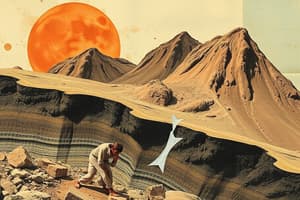Podcast
Questions and Answers
Which geological feature is characterized by the slippage of two sides of a fault relative to each other during an earthquake?
Which geological feature is characterized by the slippage of two sides of a fault relative to each other during an earthquake?
- Ground subsidence
- Surface faulting (correct)
- Landslides
- Soil liquefaction
What phenomenon occurs when loose or compressible soils experience settlement or depression due to the vibratory effect of earthquakes?
What phenomenon occurs when loose or compressible soils experience settlement or depression due to the vibratory effect of earthquakes?
- Soil liquefaction
- Landslides
- Ground cracking
- Ground subsidence (correct)
What is the cause of fissures, scarps, horsts, and grabens on the ground surface during an earthquake?
What is the cause of fissures, scarps, horsts, and grabens on the ground surface during an earthquake?
- Soil liquefaction
- Ground cracking (correct)
- Surface faulting
- Ground subsidence
Which phenomenon is characterized by the temporary change of fine saturated granular soils from a solid to a liquid state, causing them to lose their ability to carry loads or remain stable?
Which phenomenon is characterized by the temporary change of fine saturated granular soils from a solid to a liquid state, causing them to lose their ability to carry loads or remain stable?
Which of the following is often triggered by strong earthquakes and represents the failure of marginally stable slopes?
Which of the following is often triggered by strong earthquakes and represents the failure of marginally stable slopes?
If a structure lies across a surface fault, what potential damage could occur during an earthquake?
If a structure lies across a surface fault, what potential damage could occur during an earthquake?
Which type of ground deformation is characterized by the slippage of two sides of a fault relative to each other during an earthquake?
Which type of ground deformation is characterized by the slippage of two sides of a fault relative to each other during an earthquake?
What phenomenon is characterized by the temporary change of fine saturated granular soils from a solid to a liquid state, causing them to lose their ability to carry loads or remain stable?
What phenomenon is characterized by the temporary change of fine saturated granular soils from a solid to a liquid state, causing them to lose their ability to carry loads or remain stable?
Which type of ground deformation is caused by the compaction of loose or compressible soils due to the vibratory effect of earthquakes?
Which type of ground deformation is caused by the compaction of loose or compressible soils due to the vibratory effect of earthquakes?
What is the cause of fissures, scarps, horsts, and grabens on the ground surface during an earthquake?
What is the cause of fissures, scarps, horsts, and grabens on the ground surface during an earthquake?
Which type of ground deformation is often triggered by strong earthquakes and represents the failure of marginally stable slopes?
Which type of ground deformation is often triggered by strong earthquakes and represents the failure of marginally stable slopes?
If a structure lies across a surface fault, what potential damage could occur during an earthquake?
If a structure lies across a surface fault, what potential damage could occur during an earthquake?
What is the primary source of tsunamis?
What is the primary source of tsunamis?
How do seiches differ from tsunamis?
How do seiches differ from tsunamis?
What is the primary reason fires have been the most devastating indirect effect of earthquakes?
What is the primary reason fires have been the most devastating indirect effect of earthquakes?
What is the primary reason for the catastrophic height of tsunamis when they reach coastal areas?
What is the primary reason for the catastrophic height of tsunamis when they reach coastal areas?
Which of the following is NOT a potential effect of soil liquefaction during an earthquake?
Which of the following is NOT a potential effect of soil liquefaction during an earthquake?
If a structure lies across a surface fault, what potential damage could occur during an earthquake?
If a structure lies across a surface fault, what potential damage could occur during an earthquake?
Flashcards are hidden until you start studying
Study Notes
Earthquake-Related Geological Features and Hazards
- Surface faulting is a geological feature associated with the generation of earthquakes, causing structures to be damaged when the fault slips during an earthquake.
Ground Cracking and Subsidence
- Ground cracking occurs when soil loses support and sinks, or is transported to a different location, causing fissures, scarps, horsts, and grabens on the ground surface.
- Ground subsidence is a phenomenon where the ground surface settles or depresses due to compaction induced by earthquake vibrations, commonly occurring in sites with loose or compressible soils.
Landslides and Soil Liquefaction
- Landslides are often triggered by strong earthquakes, representing the failure of marginally stable slopes that become unstable due to violent shaking.
- Soil liquefaction is a phenomenon where fine saturated granular soils temporarily change from a solid to a liquid state, losing their ability to carry loads or remain stable, commonly observed during earthquakes.
Tsunamis and Seiches
- Tsunamis are large sea waves generated by a sudden depression of the ocean floor, often caused by the slippage of undersea earthquake faults.
- Seiches are long-period oscillating waves generated by distant earthquakes in enclosed bodies of water, occurring when the natural frequency of the water body matches the frequency of the incoming earthquake waves.
Fire Hazards
- Fires are a devastating indirect effect of earthquakes, often started when earthquakes break gas pipes, destroy oil-storage tanks, or cause overturned stoves, furnaces, and heaters to ignite.
Studying That Suits You
Use AI to generate personalized quizzes and flashcards to suit your learning preferences.




